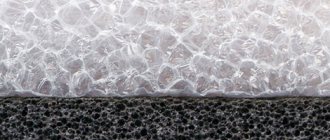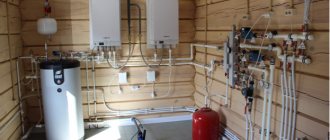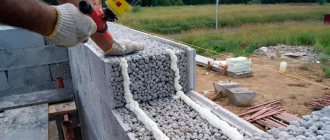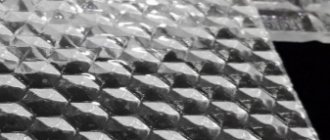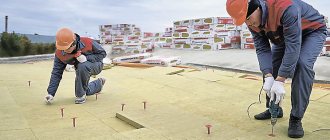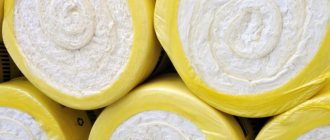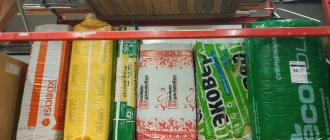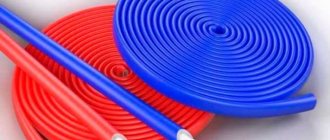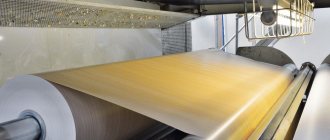Polyethylene foam is a group of elastic elastic materials with a closed porous structure, belonging to the class of gas-filled porous plastics.
Unlike most other polymers that have narrow-profile applications, polyethylene foam is universal.
The combination of heat, sound and waterproofing properties combined with high chemical resistance explain its use in the industrial and domestic sectors.
The raw material for polyethylene foam is granulated polyethylene LDPE and HDPE, including recycled polyethylene obtained by processing film and other waste.
Production stages
The polyethylene foam production line consists of:
- extruder;
- compressor for gas supply;
- cooling lines;
- packaging.
Depending on the type of final product, the equipment may be called bag-making, pipe-stitching, etc.
Additionally, flying shears and punching presses of various designs and molding machines are used.
A granule of LDPE, HDPE or compositions based on them is loaded into the receiving hopper.
Trimmings, the main type of polyethylene foam production waste, are returned to the production cycle after minimal processing.
Many enterprises mix primary raw materials with regranulate .
The main requirements for secondary raw materials for the production of foamed polyethylene are the absence of mechanical impurities, the same type in color and average molecular weight as primary PE.
If the requirements are met, the quality, operational and mechanical properties of the finished product do not suffer.
Kinds
Based on foamed polyethylene, many types of insulation are produced with different purposes: heat, hydro, and noise insulation. There are several options that are most widespread.
- Polyethylene foam with foil on one or both sides. This type is a variant of reflective insulation, most often sold in rolls with a sheet thickness of 2–10 mm, cost per 1 sq. m – from 23 rubles.
- Double mats made of polyethylene foam. They are classified as basic thermal insulation materials and are used to cover flat surfaces, such as walls, floors or ceilings. The layers are connected to each other by thermal soldering and are completely sealed. Sold in the form of rolls and slabs with a thickness of 1.5–4 cm, cost per 1 sq. m – from 80 rubles.
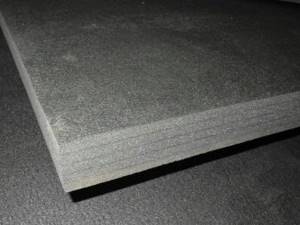
- "Penofol" is a branded product from a well-known manufacturer of building materials of the same name. Polyethylene foam of this type has good noise and heat insulation. It consists of a sheet of polyethylene foam with perforation and a self-adhesive layer, ensuring convenient installation. Sold in rolls 3–10 mm thick with a length of 15–30 cm and a standard width of 60 cm. The cost of 1 roll is from 1,500 rubles.
- "Vilatherm" is a heat-insulating sealing harness. It is used for thermal insulation of door and window openings, ventilation and chimney systems. The operating temperature of the product ranges from -60... +80 degrees C. It is sold in skeins with a rope cross-section of 6 mm. Cost per 1 linear meter – from 3 rubles.

Physicochemical characteristics
Here are the main properties of the material :
- The lower limit of operating temperatures is -80 °C. When going beyond it, the material loses its elasticity and becomes brittle.
- Melting point is about 110 °C. Some manufacturers offer compositions with an upper limit of 140 °C.
- Water absorption (with direct contact) does not exceed 1.2%.
- The tensile strength is 0.015 - 0.5 MPa.
- The material is resistant to most aggressive compounds, including petroleum products, and biologically active environments.
- Service life reaches 100 years.
Data on thermal conductivity in comparison with other types of gas-filled polymers are given in the table:
| Material | Density, kg/m3 | Thermal conductivity, W/m ° K |
| Polyethylene foam | 20 – 400 | 0, 029 – 0,05 |
| Polypropylene foam | 20 – 200 | 0, 034 |
| Polyurethane foam | 60 – 600 | 0,02 – 0,04 |
| Foam rubber | 12 – 60 | 0,03 – 0,06 |
| Expanded polystyrene | 15 – 150 | 0,027 – 0,042 |
| Polyvinyl chloride foam | 15 – 700 | 0,035 – 0,045 |
Data taken from manufacturers' advertising offers.
Classification
Polyethylene-based foams are classified according to the following criteria :
- type of feedstock;
- foaming method;
- stitching method.
For the manufacture of PPE, PVD and HDPE granules are used, as well as various compositions based on them. The molecular structure of any type of polyethylene makes it possible to obtain materials with predictable properties.
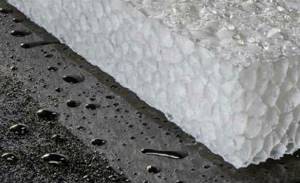
two methods are used to create a gaseous phase :
- Physical. This is the direct injection of gas (butane or other light saturated hydrocarbons) into the molten feedstock - the cheapest foaming method. However, it requires the use of specialized equipment and compliance with increased fire safety precautions.
- Chemical. Reagents are introduced into the feedstock, which decompose and release gases. Chemical foaming can be performed on standard foundry and extrusion equipment. The composition of the additives is determined by the requirements for density and cell size.
Modern production technologies make it possible to obtain various molecular structures of gas-filled polyethylene:
- Unstitched (NPE). It is obtained using physical foaming technology. At the same time, polyethylene retains the original structure specified during synthesis. NPE is distinguished by relatively low strength characteristics and its use is justified under conditions of minor mechanical loads.
- Chemically cross-linked (CS-PPE). The technology includes the following stages: mixing raw materials with foaming and cross-linking reagents, forming an initial matrix blank, stepwise heating in a furnace. Heat treatment leads to the formation of cross-links between the polymer threads (crosslinking occurs), and then gas formation occurs. Products made from CS-PPE have a fine-porous structure, a matte surface and higher mechanical properties compared to products made from NPE: strength, tear resistance, elasticity, i.e. the ability to return to its original thickness after compression.
- Physically cross-linked (FS-PPE). The material does not contain crosslinking additives, and instead of the first stage of heat treatment, the matrix blank is treated with an electron flow, which initiates the crosslinking process. The ability to control the number of cross-links allows you to vary the characteristics of the material and cell sizes.

Unlike most structural materials, polyethylene foam is marked not by strength indicators, but by average density, i.e. the ratio of weight per unit volume (kg/m3): 15, 25, 35, 50, 75, 100, ... 500, as for example shown in the photo above.
The method for determining average density is described in GOST 409 - 2017.
Thanks to the work of marketers, domestic consumers are more familiar with the brands of polyethylene foams used, in particular, for pipe thermal insulation:
- Izolon;
- Teploflex;
- Penolon;
- Tatfoum;
- Hitfom;
- Stage, etc.
Product production is most often regulated by internal enterprise standards and technical specifications. However, in Russia, GOST R 56729-2015, corresponding to EN 14313:2009, has been developed for the production of thermal insulation materials.
Advantages and disadvantages
Insulation, characterized by a closed-cell structure, has many positive qualities:
- Versatility. The material is suitable for insulating various types of surfaces and objects.
- Excellent moisture and heat protection indicators.
- Foam coating is used as sound insulation if a material with a thickness of 5 mm or more is used.
- Light weight.
- Environmentally friendly.
- Vapor tightness.
- During combustion, the insulation does not emit toxic substances.
- Fungus and mold do not appear on the surface of PPE.
- The foam material is resistant to chemical compounds, which is important in construction.
- Elasticity.
- Elasticity.
- Reasonable price.
- Long service period.
The coating has much fewer disadvantages. These include low strength characteristics. The foam material is not resistant to compressive loads. For this reason, PPE is more often used to insulate horizontal surfaces. Under the influence of ultraviolet radiation, the insulation loses its properties, so it is either covered with a protective coating, or an option is used with a foil layer on top of the base material.
Application of polyethylene foam
Below we will describe the main areas of application.
Soundproofing
Like all cellular materials, polyethylene foam absorbs airborne noise well . A sound wave passing through a PPE layer loses a significant part of its kinetic energy due to its conversion into heat.
NPE is a good barrier to impact noise and vibration. Of all acoustic materials, it has the highest characteristics for absorbing low-frequency vibrations.
Cross-linked polyethylene foam is also used for sound insulation in residential and industrial construction, automotive and mechanical engineering.
PPE tape laid on the ceiling and walls when installing a floating screed is considered to be an effective blocker for the occurrence of structural noise.
Thermal insulation
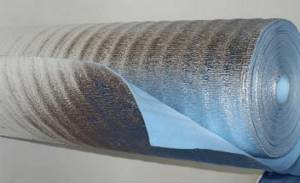
Sheet and roll polyethylene foam is used mainly indoors as part of a heat-insulating pie of facade walls, roofing, ventilation and air conditioning systems for insulating a house.
PPE for thermal insulation is covered with foil, which is an additional barrier to heat and a mirror that reflects infrared radiation .
One of the areas of application of foamed polyethylene is insulation for pipes of heating mains, cold and hot water.
Sealing and packaging
In addition to pipe thermal insulation and insulation, PPE is used to produce packaging materials for transporting fragile objects and painted structures. Vacuum forming and die-cutting machines are used to create packaging for mass-produced products that also serves as a sealant, for example, for mobile phones, electronic and electrical appliances.
What does cross-linked polyethylene mean?
Cross-linking of polyethylene foam is a processing process at the molecular level, after which a bunch of molecular links are converted into a wide-cell three-dimensional mesh due to the formation of cross-links. Crosslinking is distinguished between chemical and physical.

Photo 2. The difference between uncrosslinked and crosslinked polyethylene foam.
Recycling
To dispose of polyethylene foam waste, the same technologies are used as for non-foamed polyethylene foam - thermomechanical and thermochemical recycling , or pyrolysis.
Used PPE packaging is processed into a secondary granule, and cross-linked PPE crumbs serve as a filler for composite materials from which paving slabs and other artificial coatings are made.
The main feature of gas-filled polymers – low density – makes adjustments to the technology. During processing, PPE waste is compressed in specialized machines - thermocompactors.
On the equipment market you can find devices with a compression ratio of up to 90:1. PPE briquetted in compactors can be loaded into an extruder or thermal oven and used as a raw material for the production of polyethylene wax.
